

Matt Campbell
2026 MG U9 review
4 Hours Ago
We pitch the new Kia Niro Hybrid against the established Toyota C-HR in this compact petrol-electric crossover duel.

Marketplace Editor


Marketplace Editor
Sales of electrified vehicles are steadily rising, and the range of options available to Australian buyers is increasing as well.
The most affordable form of electrification is the humble hybrid car, synonymous with Toyota. That company’s Australian division has sold 100,000 in less than three years. But finally some competition is coming on stream.
Kia sells the Niro crossover in hybrid guise – as well as plug-in hybrid and electric forms – and plans to offer such electrification across other model lines over the coming months in the Sorento and (possibly) Sportage.
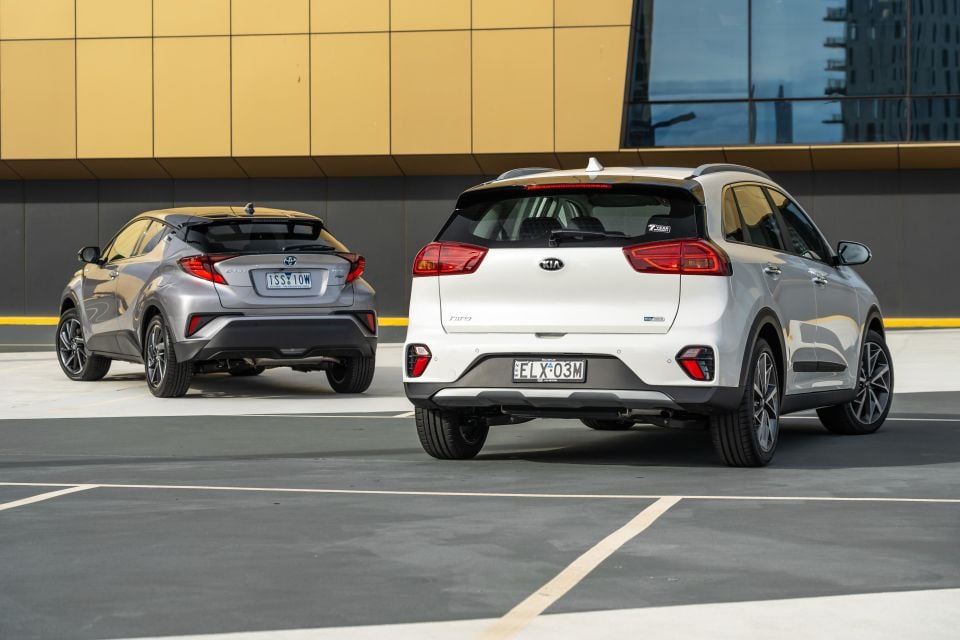
In this test we’re pitting the Niro Hybrid Sport against its most direct competitor by price and VFACTS segmentation: the Toyota C-HR Koba Hybrid.
Both vehicles cost north of $40,000 once you factor in on-road costs, both feature petrol-electric motivation, and both are at the top of their respective model line-ups in terms of specs.
Can the Korean brand finally offer a viable challenger to Toyota’s reputable hybrid brand?
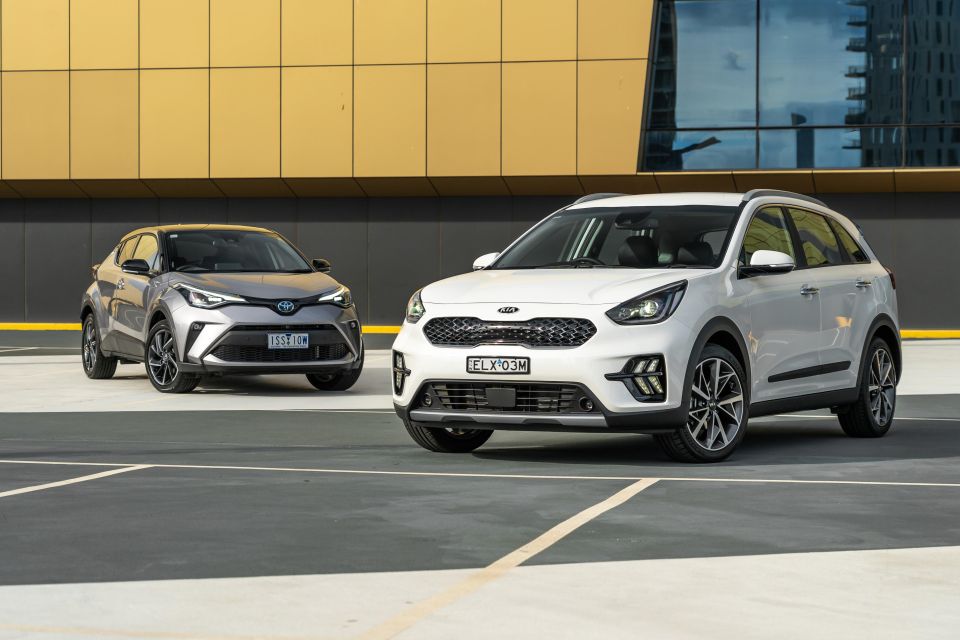
As noted earlier we have the flagship specifications of both vehicles.
The 2021 Toyota C-HR Koba Hybrid is the more affordable of our subjects at $37,665 plus on-road costs, or about $42,000 drive-away according to Toyota’s website.
Our test vehicle featured a metallic two-tone paint job, which adds $1350. As tested, you’re looking at $43,405 drive-away with a Melbourne postcode.
Meanwhile, the 2021 Kia Niro Hybrid Sport lists for a significantly higher $43,890 but in typical Kia form there’s discounted drive-away pricing – advertised as $45,990 drive-away at the time of writing.
Our test vehicle’s Snow White Pearl paint is a further $520, bringing the as-tested sticker to $46,566 at the time of writing.
The Toyota leads with a $3000 advantage.
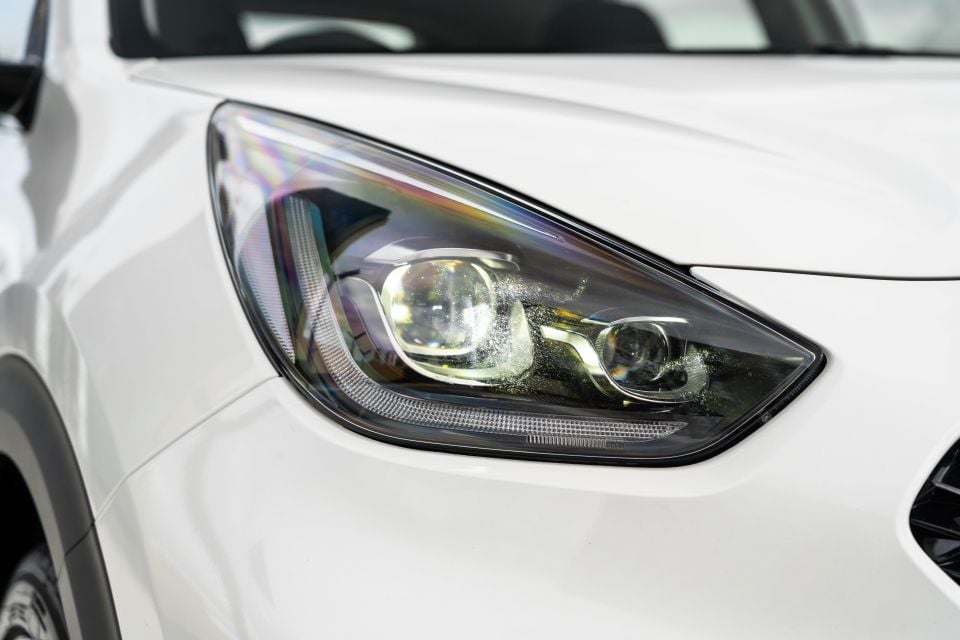
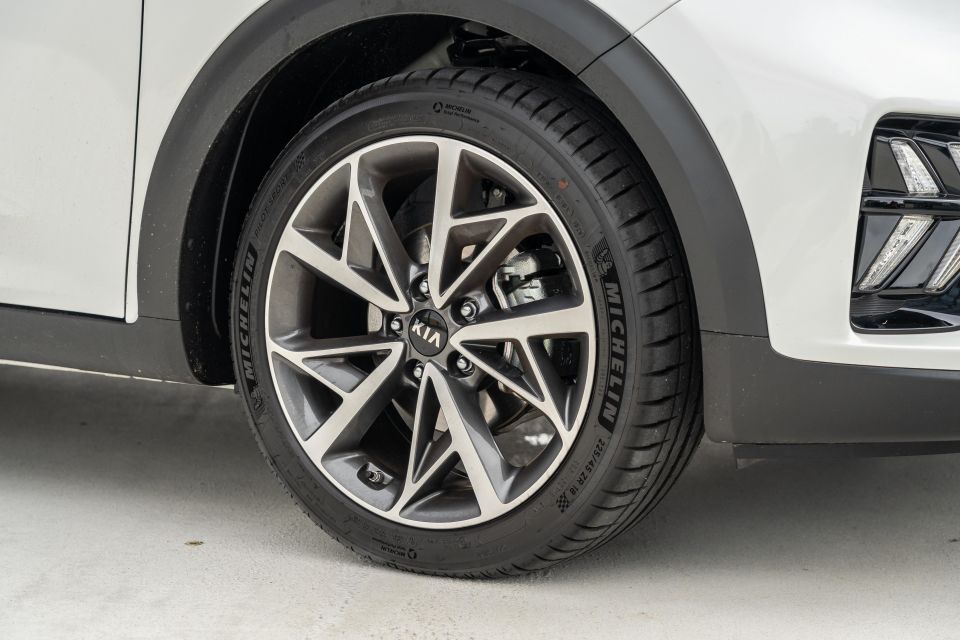
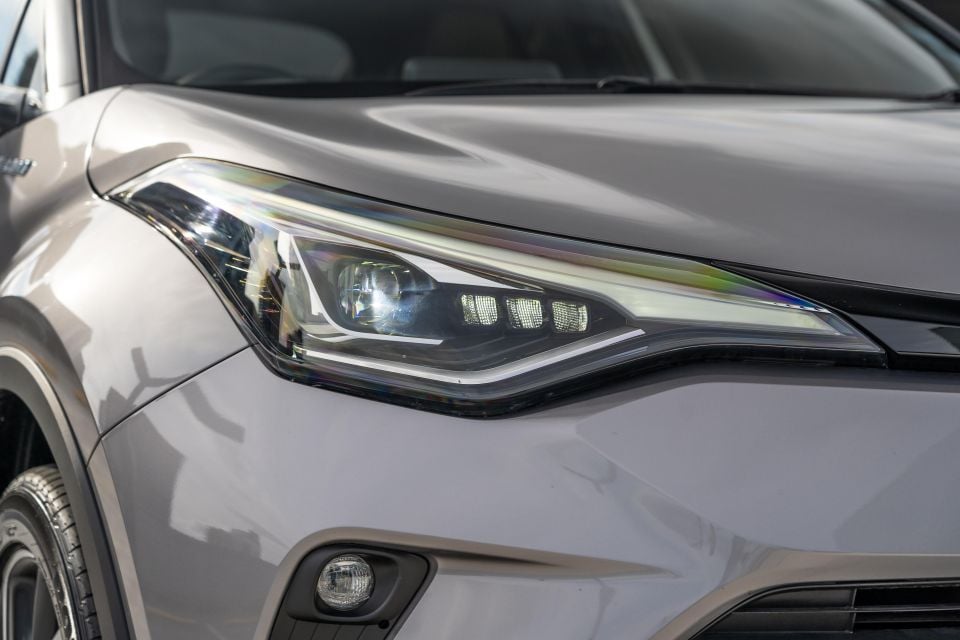
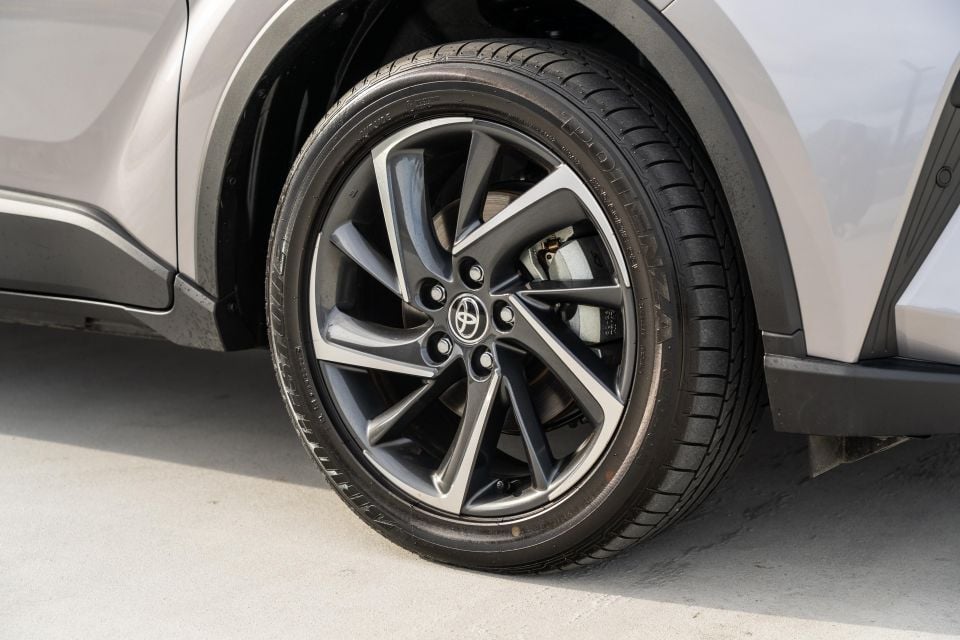
Both models here being the top specifications are pretty well equipped, though their advancing ages in their respective life cycles mean both miss out on features offered by the other or by newer vehicles within their own stables.
Common features to both include touchscreen infotainment systems with inbuilt satellite navigation, wired Apple CarPlay/Android Auto, leather-accented trim, dual-zone climate control, and LED lighting front and rear.
The Toyota gets heated seats over the Kia, as well as a surround-view camera system, dynamic rear indicators, along with keyless entry with push-button start.
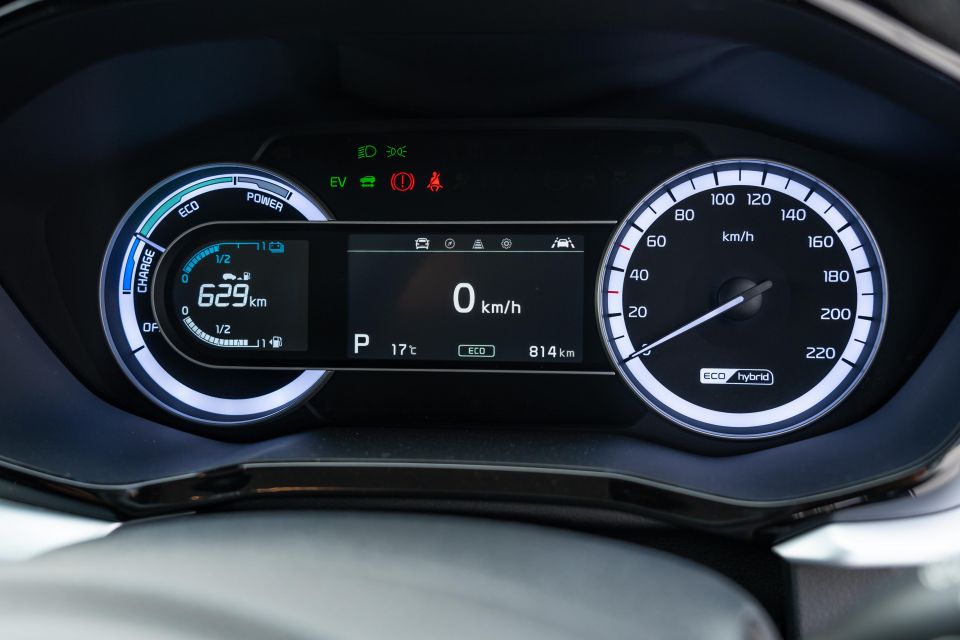

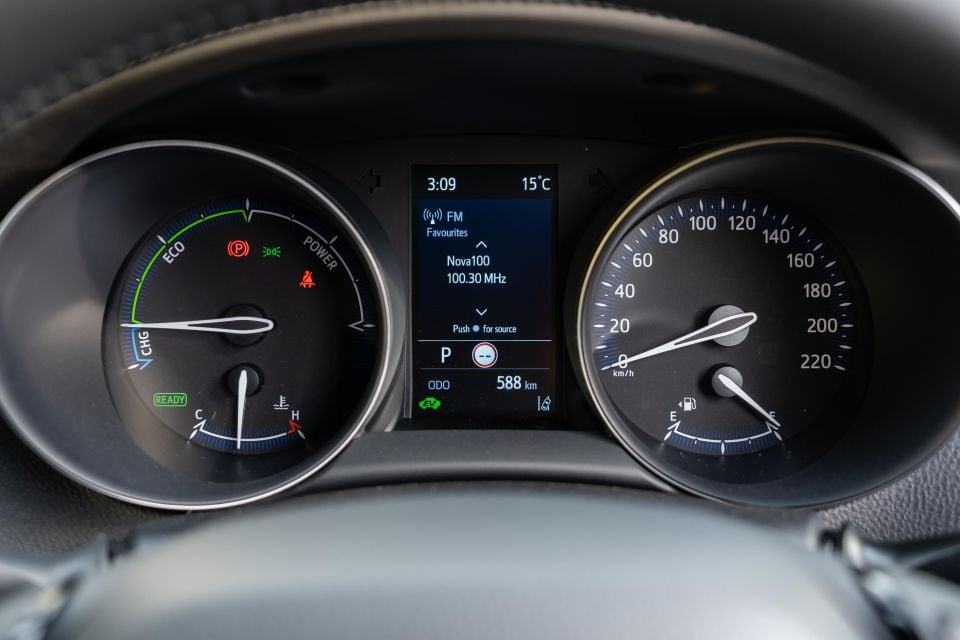
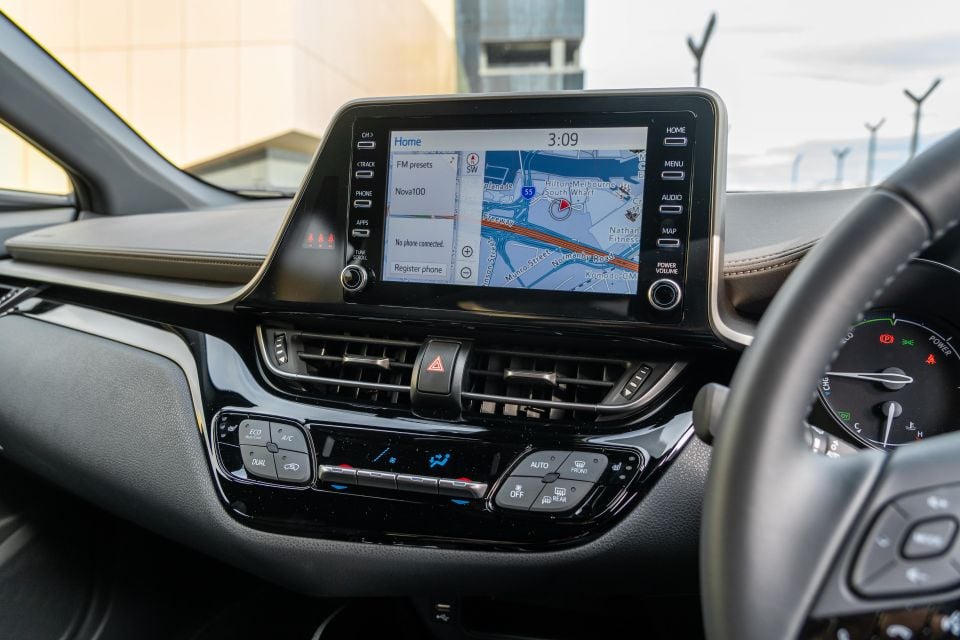
Meanwhile, the Niro counters with 18-inch alloys (vs. 17-inch rims), a larger 10.25-inch touchscreen (vs. 8.0 inches), and directional rear air vents.
Unfortunately, Kia Australia hasn’t brought over the full catalogue of features available in the Korean domestic market, including heated/ventilated front seats, driver’s seat memory, a premium sound system, 7.0-inch driver’s display, or a wireless phone charger to name a few.
The Niro is a larger vehicle with more space in the second row and boot, however, though we’ll get to that in the interior comparison.
For now, the Toyota maintains its lead on features and standard specification.
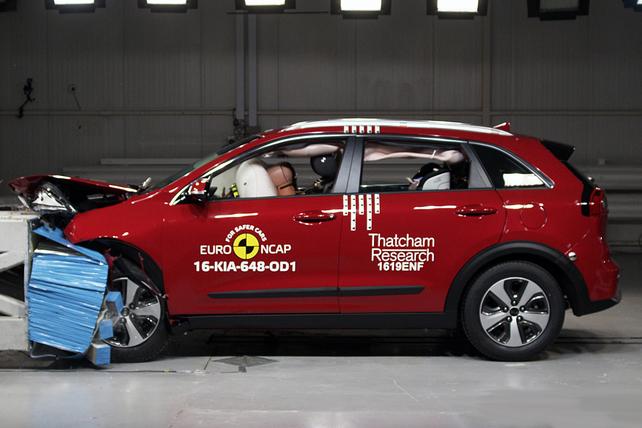
Both vehicles wear five-star ANCAP and Euro NCAP safety ratings, though there are variances in the scoring.
The Kia has an older 2016 datestamp compared to the C-HR’s 2017 test date, though the former scored higher in physical crash protection for adults and children.
According to ANCAP, the Kia Niro managed 91 per cent for adult occupant protection, 80 per cent for child occupants, 70 per cent for pedestrian detection and 81 per cent for safety assist.
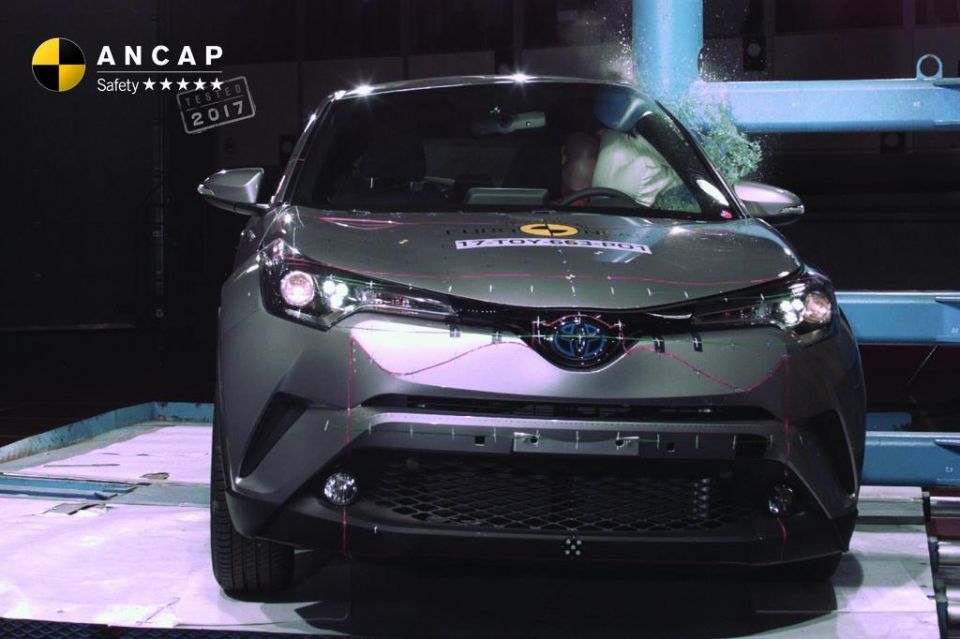
By comparison, the C-HR scored 87 per cent for adult occupant protection, 77 per cent for child occupant protection, 65 per cent pedestrian protection and 68 per cent for safety assist.
Common safety features to both vehicles include seven airbags (incl. driver’s knee), AEB with pedestrian and cyclist detection, lane-keep assist, active lane centring, adaptive cruise control with stop and go, blind-spot monitoring, rear cross-traffic alert (he Toyota gets cross-traffic assist with AEB intervention), auto high-beam and reversing cameras.
There are also ISOFIX child seat mounts for the outboard rear seats in both vehicles, as well as top-tether points for all three second-row positions.
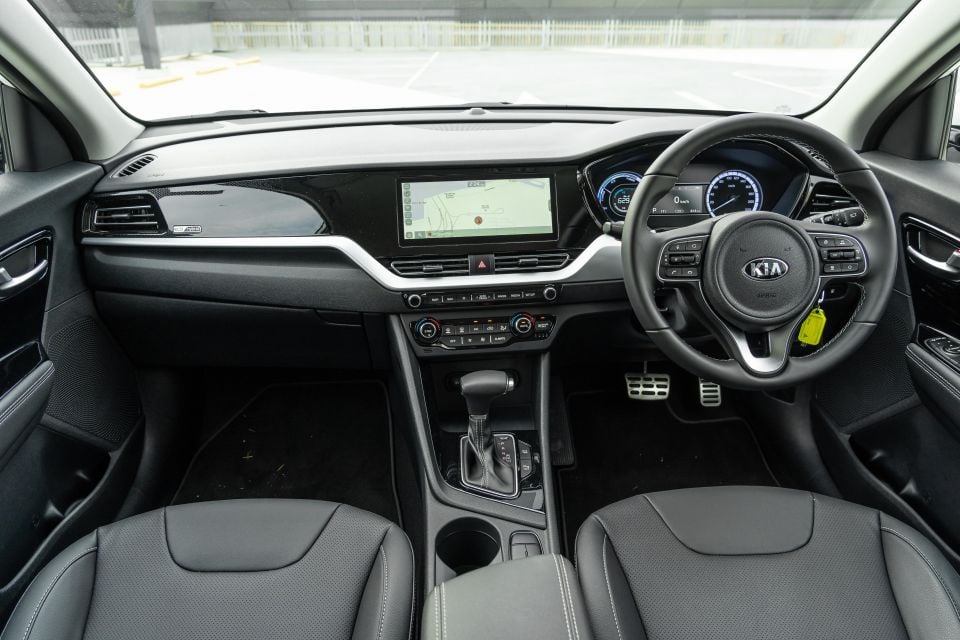
Kia Niro
The Niro first launched overseas in 2016 and it feels that way inside, with a design and layout that harks back to the previous generation of Kia’s products.
It’s not necessarily a bad thing, if you lament the current trend of tablet-style screens and digital driver’s clusters, but for tech-savvy me it’s a little old-hat.
It’s largely well finished, though, and the straight lines give an impression of width and space.
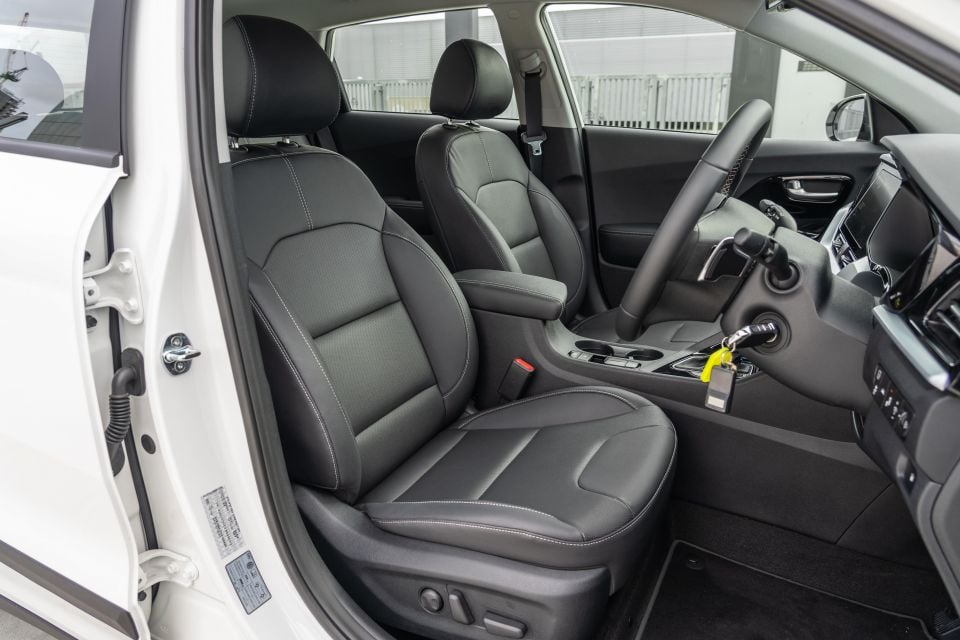

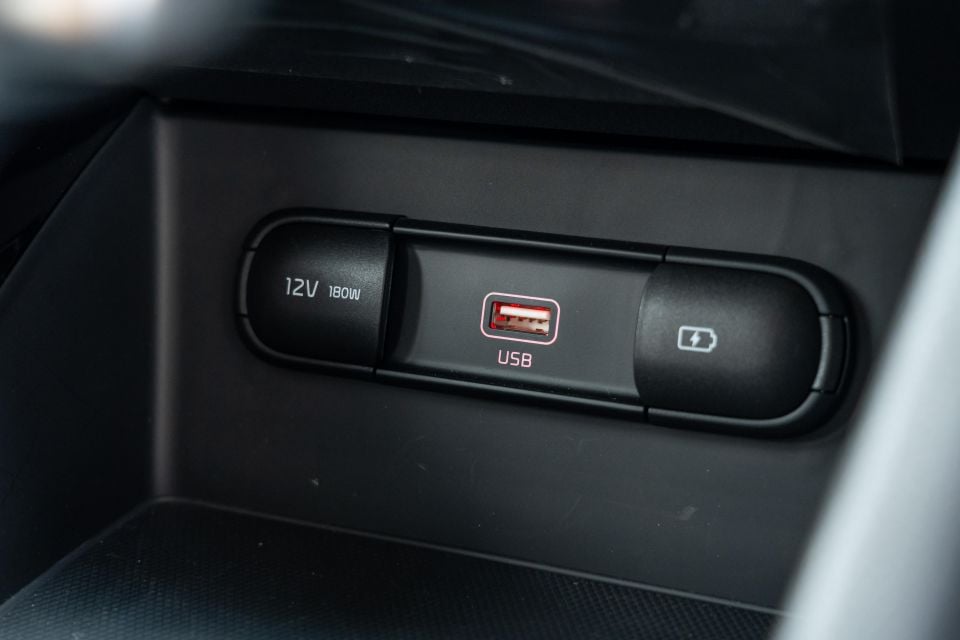

The highlight is that 10.25-inch touchscreen infotainment system, which is not only better than the Toyota’s on paper but a significant step forward in resolution, response and ease of use.
It’s snappy to respond to inputs, offers beautiful clarity, and feels quite upmarket in execution. The Hyundai/Kia system could teach some European brands a thing or two.
There’s soft-touch materials on the dash and doors, though the black-on-black colour scheme offers little visual excitement. Same goes for the instrument cluster, offering a 4.2-inch colour trip computer display with digital speedo, a hybrid power meter, and speedo dial that are basic but clean.
Also, key ignition – really, Kia?! On a $46,000 high-spec crossover the brand couldn’t opt for push-button start? You can get the base Audi Q3 for similar money with that. Jeez.
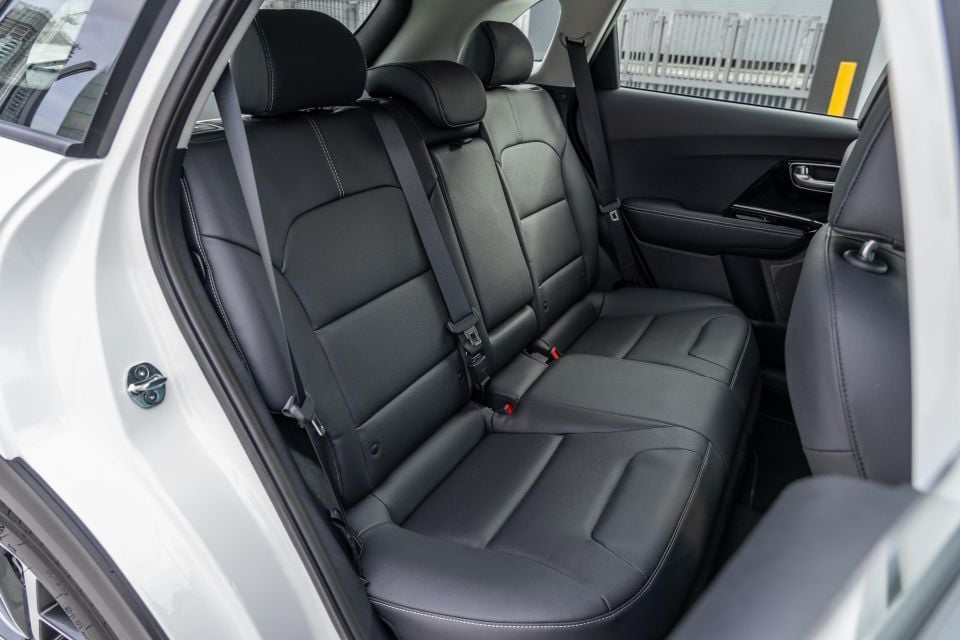
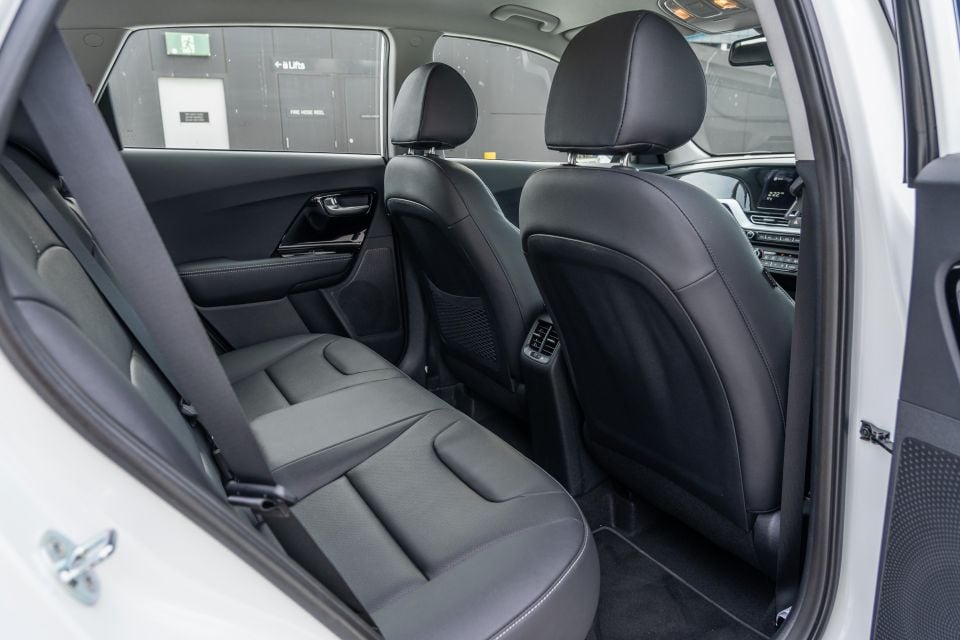
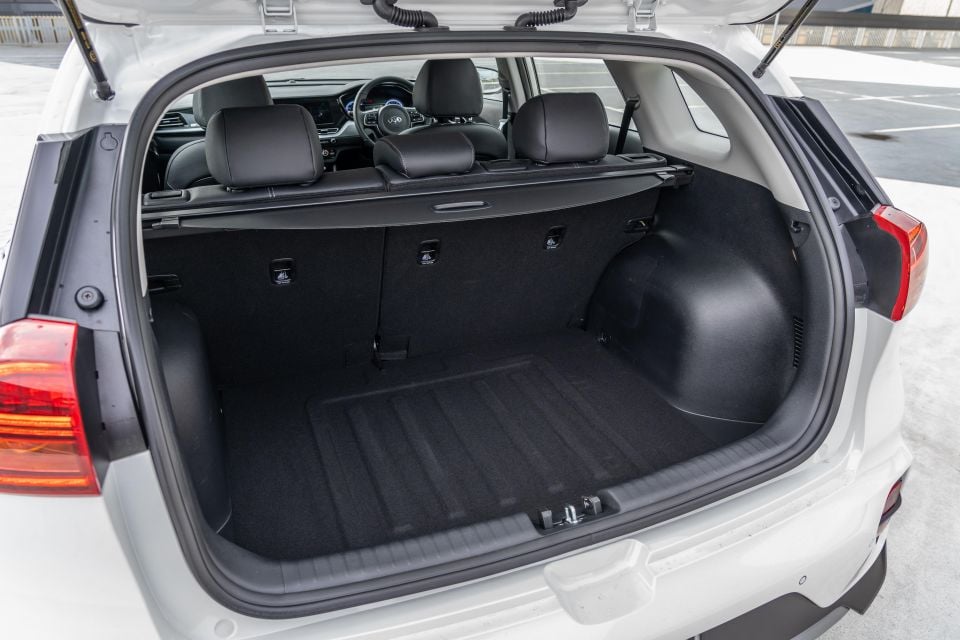
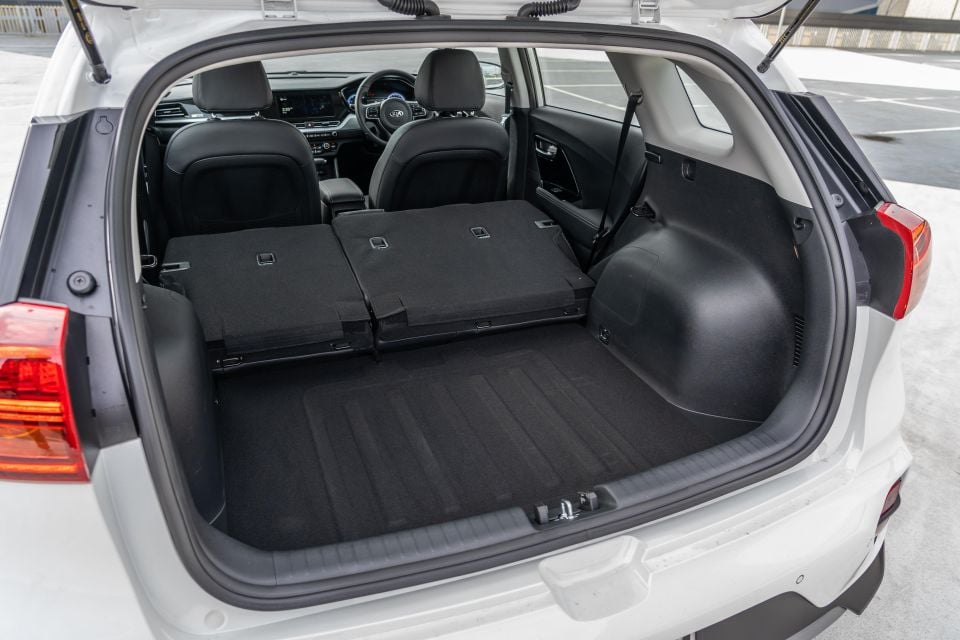
In the second row, there’s more passenger space than the Toyota, rear air vents, and larger windows that mean better outward visibility.
Only the front passenger seat has a map pocket mounted on the back, though the fold-down rear centre armrest with cupholders is another win for the Korean.
The rear seats fold with a 60:40 ratio which is typical for the segment, and there’s a healthy 410L of boot space in five-seat configuration. Fold the second row down and you have 1408L to play with, and a space-saver spare under the boot floor.
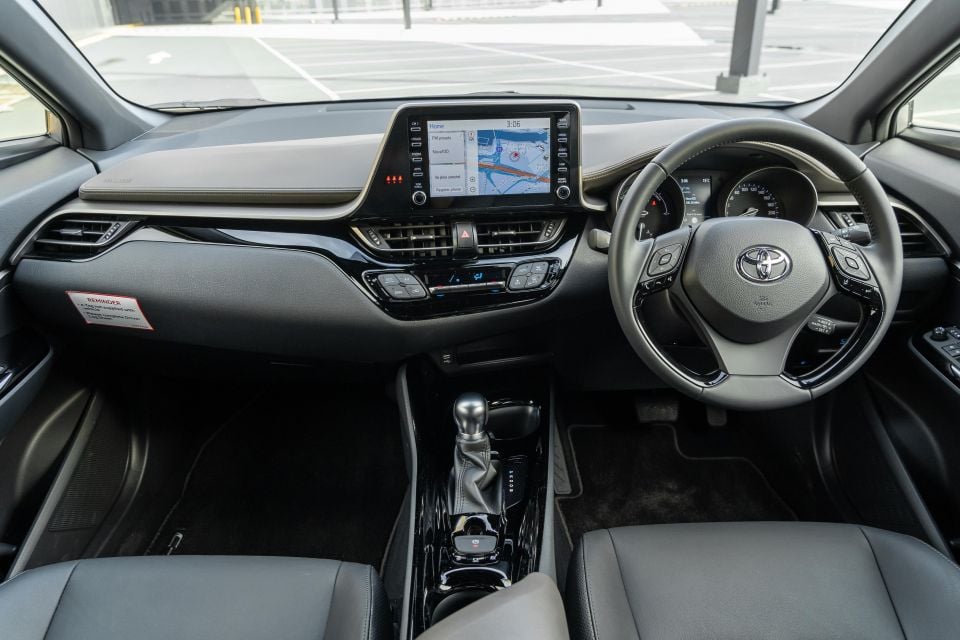
Toyota C-HR
As soon as you hop in the driver’s seat the Toyota C-HR feels more modern.
There’s the diamond design motif throughout, including for the switchgear, needles, imprints in the headliner, and in the door inserts. It helps to add a bit of visual excitement.
In typical Toyota fashion everything is ergonomically laid out and quite user-friendly, if a touch basic.
The smooth leather steering wheel is quite compact and feels lovely to hold, the metallic gearshift is nice in the hand, and the chunky climate control buttons have a feeling of solidarity.
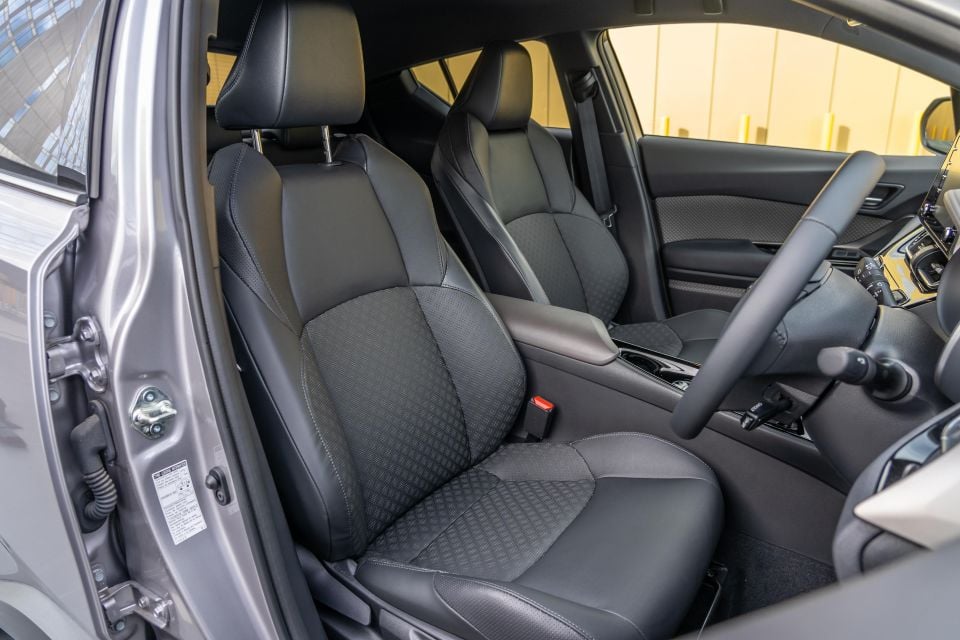

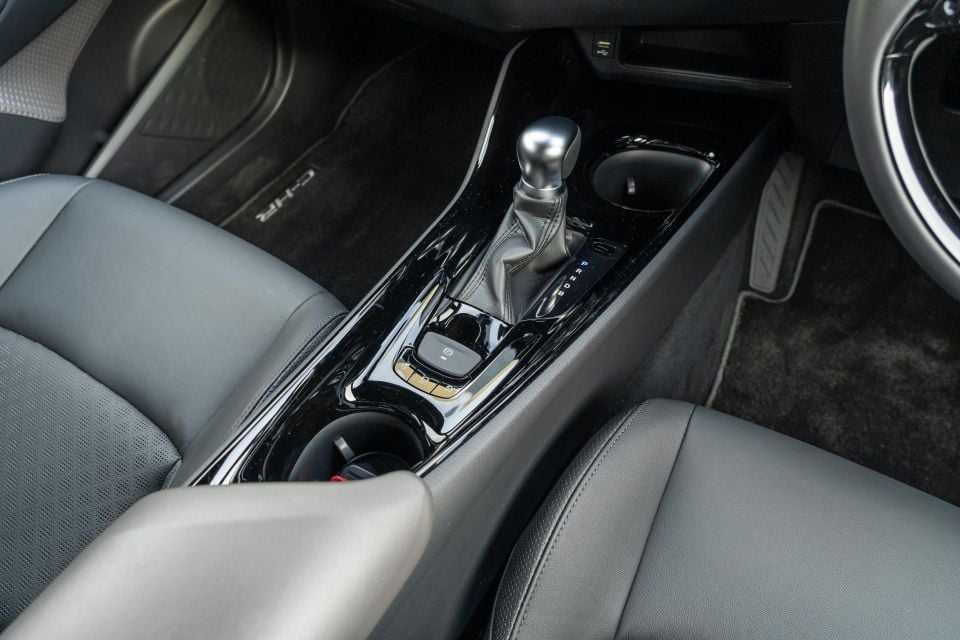

Ambience-wise, the C-HR feels more like a small, sporty hatchback with its dark headliner, sharply raked windscreen as well as the high-set console and window line.
It certainly feels more youthful and upbeat than the Kia’s cabin, and the nice mix of materials feels closer to ‘premium’ territory.
Toyota’s 8.0-inch infotainment system is a far cry from the aftermarket-looking head unit previously fitted to Australian-market C-HRs, but it’s still not a real challenger to the Kia’s system. Load times are slower, the graphics aren’t as sharp and in everyday use it just feels average.
Sound quality from the JBL premium audio system is pretty good, though, as it helps to drown out ambient tyre roar on the highway. Like the Niro, the driver’s seat is electrically adjustable and it’s very easy to get comfortable up front.
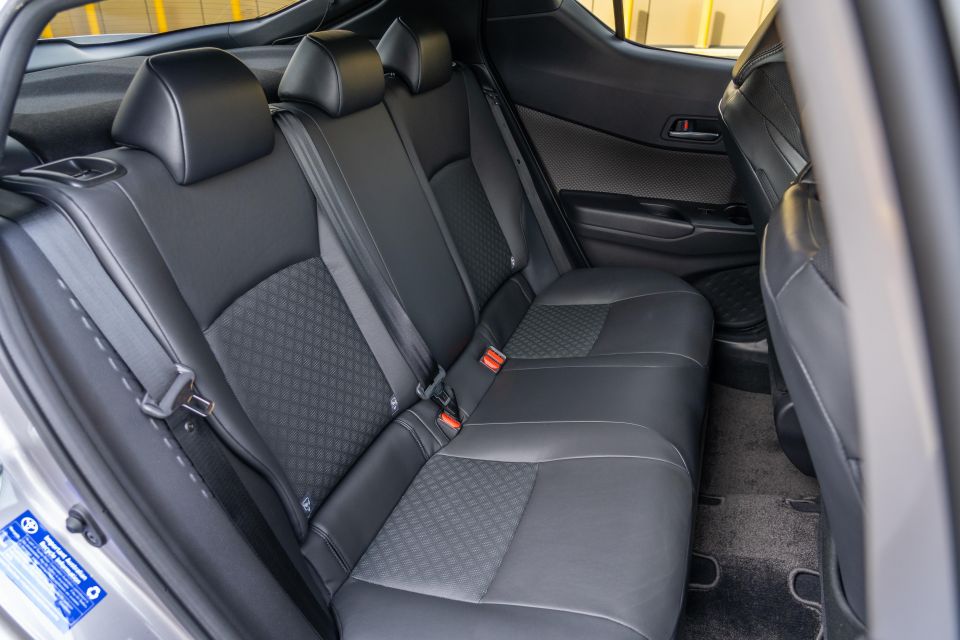
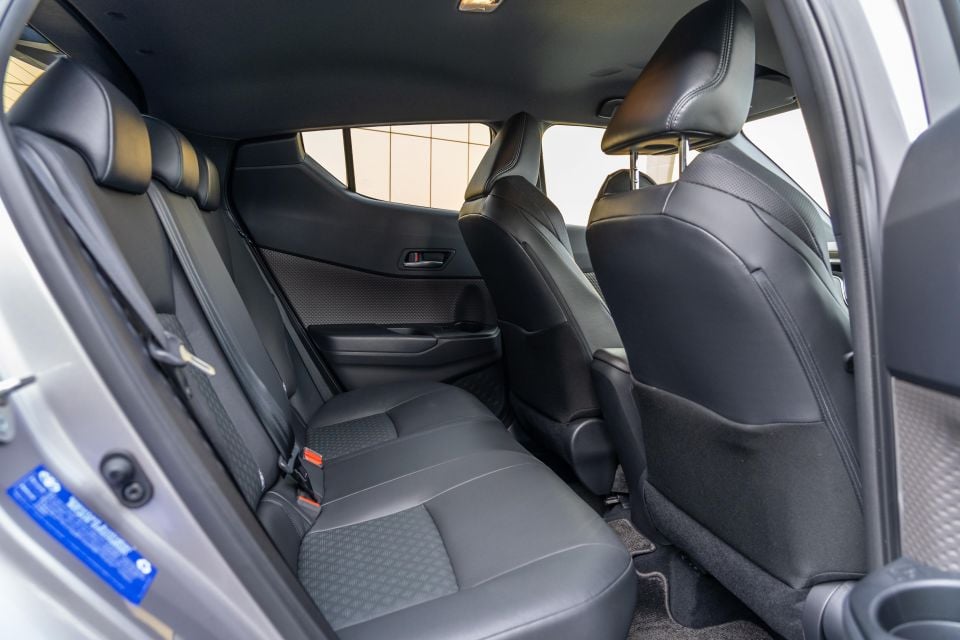
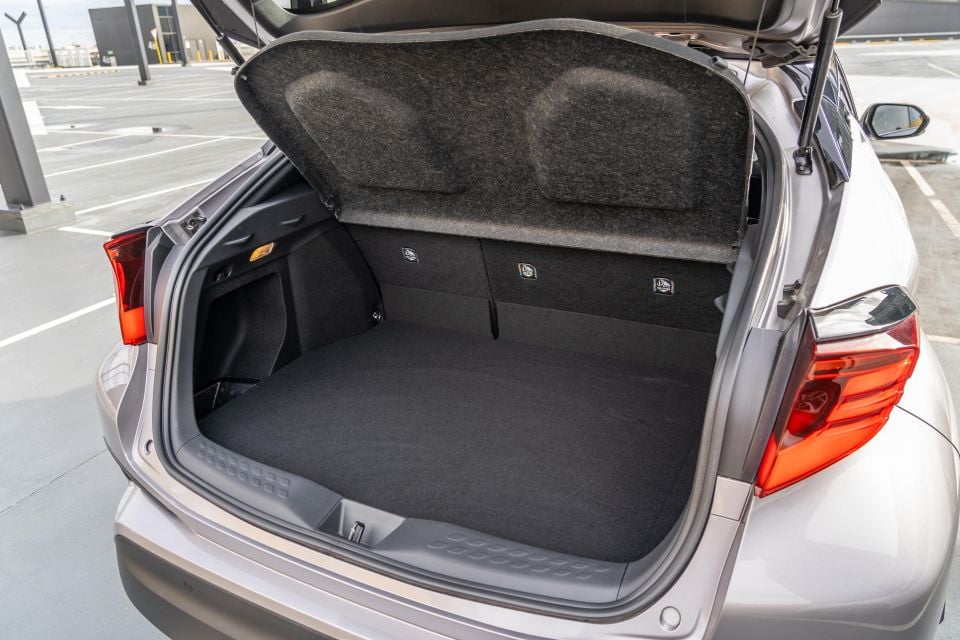
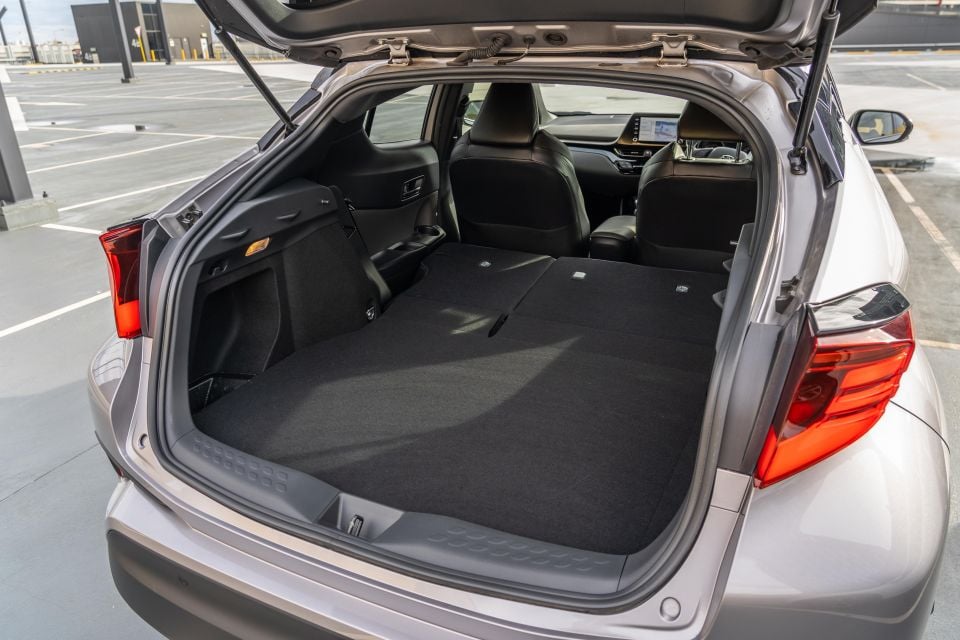
Things aren’t so bright and airy in the back, with the rising window line limiting outward visibility and the dark trimmings and headliner making the second row feel very dark and somewhat claustrophobic.
Headroom is fine, even for taller passengers despite that sloping roofline, though knee and legroom is on the tighter side, especially compared to the Kia. Further, there’s no rear air vents or fold-down centre armrest.
There are ISOFIX mounts on the outboard positions, as well as three top-tether points, but if your little ones are prone to getting car sick the C-HR wouldn’t be my pick.
Behind the rear seats there’s 318L of quoted luggage capacity, some 92L less than the Niro. Toyota also doesn’t quote a maximum capacity with the second row folded, but the high floor makes a flat load bay unlike the Kia.
| Kia Niro | Toyota C-HR | |
|---|---|---|
| Length | 4355mm | 4390mm |
| Width | 1805mm | 1795mm |
| Height | 1545mm | 1565mm |
| Wheelbase | 2700mm | 2640mm |
| Boot | 410L | 318L |
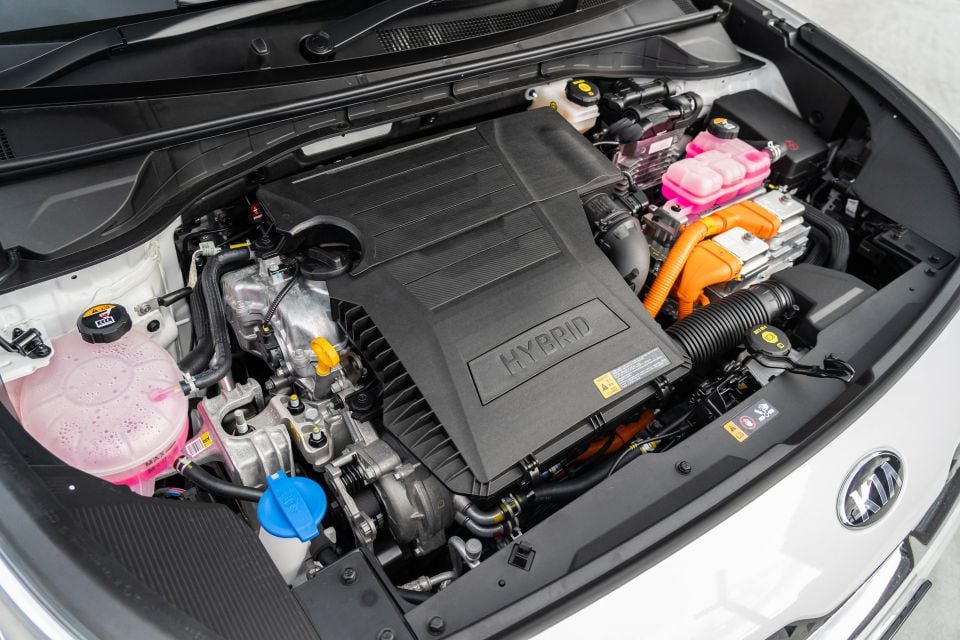
Where expert car reviews meet expert car buying – CarExpert gives you trusted advice, personalised service and real savings on your next new car.
Kia Niro
A 77.2kW/147Nm 1.6-litre ‘GDi’ naturally-aspirated four-cylinder petrol engine with direct injection is teamed with a 32kW/170Nm electric motor and a 1.56kWh lithium-ion battery pack mounted under the rear seat.
System outputs are rated at 104kW (5700rpm) and 265Nm (4000rpm), with drive sent to the front wheels via a six-speed dual-clutch automatic transmission. The electric motor is parallel – i.e. mounted to the transmission.
Kia claims the Niro Sport with its 18-inch rims and Michelin Pilot Sport performance tyres will return 4.4L/100km on the combined cycle, with 91RON regular unleaded compatible with the 45L fuel tank. Theoretically, it should be able to nudge 1000 kilometres between fills.

Toyota C-HR
Power in the C-HR Hybrid comes from a 1.8-litre petrol engine teamed with an electric motor and battery pack shared with the related Corolla small car – specs aren’t disclosed officially for the electrified components in Toyota’s consumer materials.
The front-driven petrol-electric drivetrain quotes a system output of 90kW, which is 5kW more than the 1.2-litre turbo petrol engine offered on GXL and Koba models.
Like other Toyota hybrid models, there’s no torque output quoted.
Drive is sent to the front wheels via a CVT automatic, and claimed fuel use is rated at 4.3L/100km on the combined cycle.
| Kia Niro | Toyota C-HR | |
|---|---|---|
| Engine | 1.6 petrol | 1.8 petrol |
| Outputs | 77kW/147Nm | 72kW/142Nm |
| Motor | Permanent-magnet synchronous | Permanent-magnet synchronous |
| Outputs | 32kW/170Nm | 53kW/163Nm |
| System | 104kW/265Nm | 90kW |
| Battery | 6.5Ah Li-ion | 6.5Ah Ni-MH |
| Transmission | 6-DCT | e-CVT |
| Driven wheels | Front | Front |
| Fuel cons. | 4.4L/100km | 4.3L/100km |
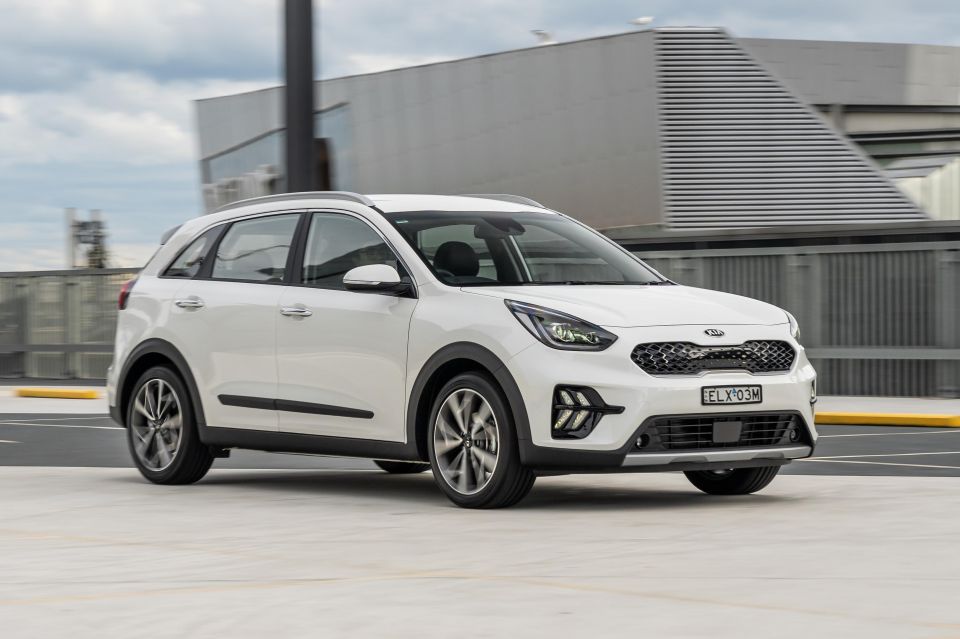
Kia Niro
It’s an interesting path Kia has taken here, because the Niro Hybrid does its best to behave like a normal car with electric assistance – but it can be hard to get your head around the revs rising and falling as the Eco meter (in place of a tacho) progresses through Eco, Power and Charge.
With just 32kW and 170Nm, the e-motor doesn’t quite have enough grunt to keep up with traffic off the line without the petrol engine cutting in, but it does a good job of getting the Niro off the line and maintaining speed once the petrol engine shuts off at urban speeds.
Revving the Niro out also doesn’t transmit a droney, thrashy note into the cabin. The 1.6L GDi petrol is essentially a non-turbo version of the engine used in the likes of the i30 N Line, Kia Seltos and Cerato GT. It’s a little buzzy at times, but it isn’t half bad.
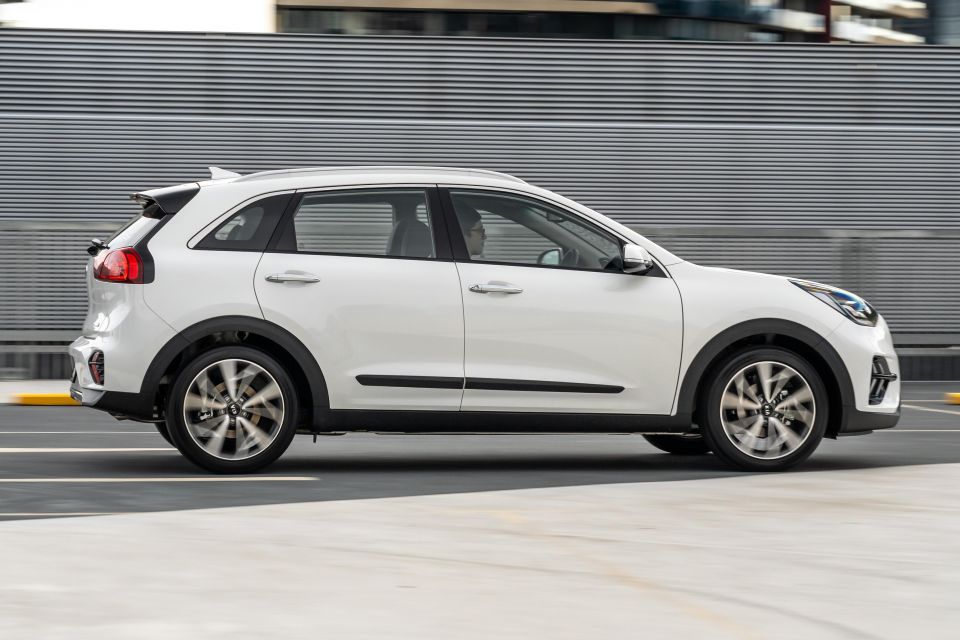
The dual-clutch transmission gets help from the electric motor to smooth out the launch process to mitigate or minimise that jerky, hesitant low-speed feel that’s a common trait of DCTs, and it mostly does a good job at shifting quickly and intuitively. As we’ve found with other Hyundai/Kia DCT-equipped models, however, the step from first to second can still have an elastic feeling.
Otherwise, the Niro feels more responsive than the C-HR, and gets up to speed in a reasonable fashion. I wouldn’t call it fast, but if you need a quick burst flick the gear selector into Sport and it gets along nicely even up to freeway speeds.
The firmer suspension tune definitely gives it a ride in line with its Sport badge, but the Niro is far from uncomfortable. It can get a touch busy over pimpled city tarmac and tram/train tracks, however.
It also isn’t the last word in on-road refinement, at least on the 18s and Michelin Pilot Sport rubber exclusive to the Hybrid Sport. There’s noticeable road noise over rougher patches of black top though it’s no worse than the C-HR. We imagine the 16-inch wheels and eco tyres of the Niro S would go some way to addressing these complaints.

From a handling perspective the Niro has a sportier setup, with a low centre of gravity compared to most crossovers and a pointy front end. The weightier steering feels progressive and accurate, and there’s taut body control in the bends – likely courtesy of the European setup local models feature.
The Niro is at its best in urban environments and on suburban highways, where its drivetrain is at its most efficient travelling between 60 and 80km/h. The petrol and electric motors work well together and it’s a nice feeling to see the EV icon constantly show up in the cluster letting you know you’re saving fuel.
At parking speeds as well, you’ll hear the Niro make a whirring, UFO-like noise that’s letting pedestrians and other road users know the vehicle is coming even when the engine is switched off. It’s identical to the noise emitted by the EV version and the Hyundai Kona Electric.
The backup ‘bong’ noise, though, isn’t as fun given it sounds like you’re backing up some cutesy truck. We can appreciate its real-world benefit, however.
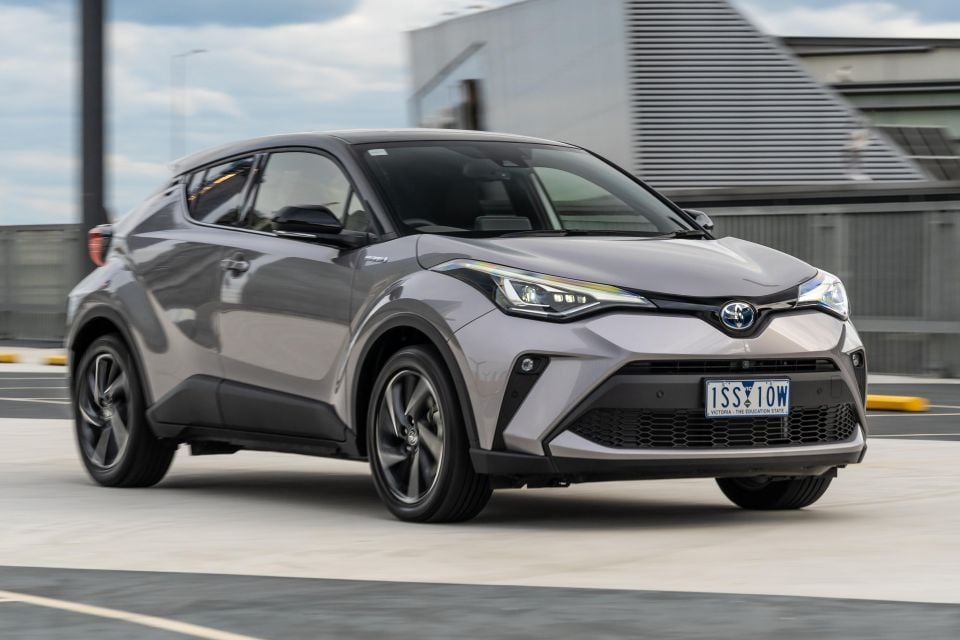
Toyota C-HR
Being based on the same TNGA platform as the Corolla as well as featuring the same petrol-electric hybrid drivetrain, the C-HR has more than a few similarities to its hatchback/sedan sibling on the road.
Its keen chassis, compact dimensions and well-weighted controls make the C-HR a fun drive in urban streets and city traffic, with the steering and handling in particular offering a level of response and engagement that could be considered ‘fun’.
However, the 1.8-litre hybrid lacks the punch to go with the C-HR’s athletic underpinnings, and the low-powered petrol engine has a habit of getting quite noise and coarse under load.
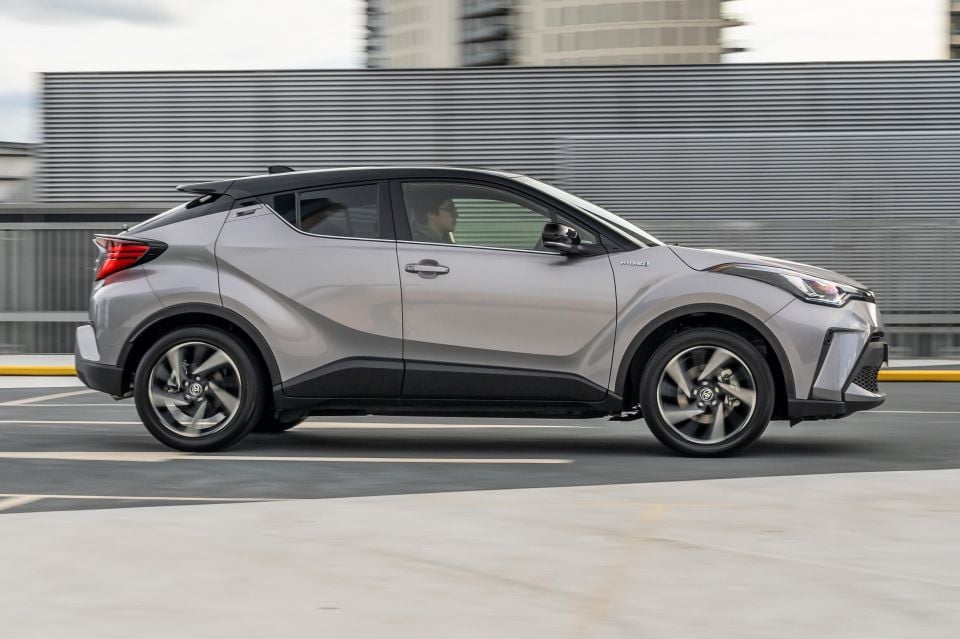
With just 90kW combined, the hybrid system has to work pretty hard above 80km/h up hills or to overtake, especially when driven back-to-back with the Kia. It’s definitely better suited to the city.
It’s a crying shame Toyota Australia still doesn’t offer the 131kW 2.0-litre hybrid system offered with European models and in the related UX250h. That extra grunt would go a long way in matching the drivetrain to the chassis’ potential.
The CVT does a good job of extracting the most out of the drivetrain and then dropping revs or coasting once the required work is done. Again, though, the lack of grunt will be a sore point for many and the C-HR Hybrid is much better suited to urban environments.
The ride is comfortable and pliant that allows for a natural level of body roll in corners that is again playing to that fun-to-drive factor. You just have no oomph coming out of said corners, even in the powertrain’s Power setting.
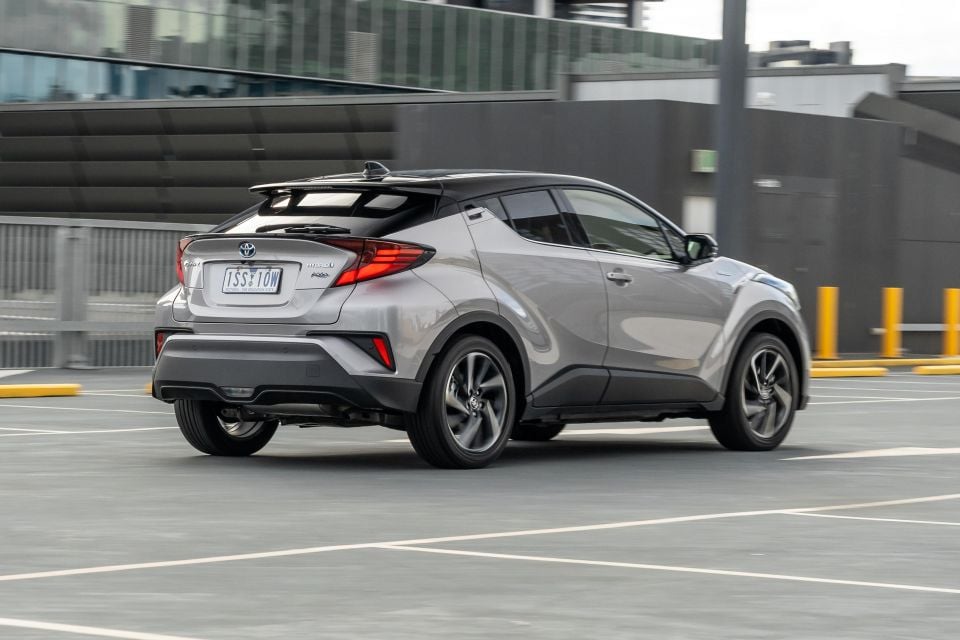
I really love Toyota’s steering calibration in its TNGA-based cars. It’s accurate, fluid and progressive with a lighter steering weight that is a good balance for everyday driving as well as more of the fun stuff.
There’s a hint of Euro premium about it actually, similar to my recent comments about the Mazda CX-30. No surprise then, as both the Toyota C-HR and Mazda CX-30 were designed with European tastes in mind.
Refinement in terms of NVH (noise, vibration harshness) is generally pretty good, though there can be quite a bit of road noise on coarser surfaces, not helped when the C-HR is drawing on just quiet electric power.
It’s no deal breaker, and it’s pretty refined in town, but like the drivetrain it limits the C-HR’s all-round capabilities.
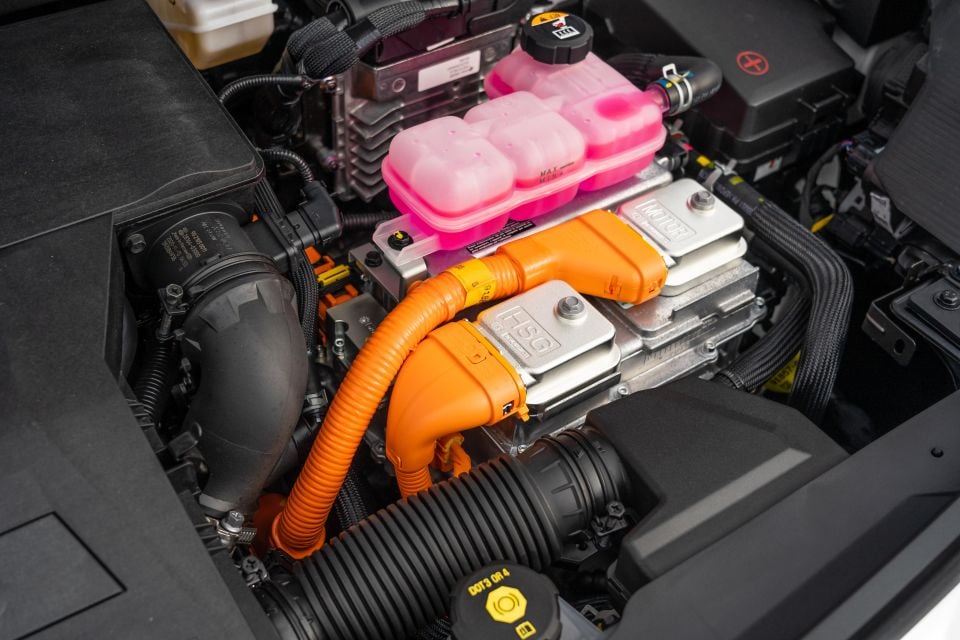

Kia Niro
Kia provides a seven-year, unlimited-kilometre warranty, with seven years of capped-price servicing (annual or 15,000km intervals) that you can pre-pay or pay as you go. There’s also seven years of roadside assist.
Exceptions to the warranty term are the high-voltage battery and electric motors which are covered by a seven-year/150,000km warranty. You’re entitled to a warranty claim if the battery loses more than 25 per cent of capacity within the seven-year period.
As for servicing, the first five visits for the Niro Hybrid and PHEV will cost $286, $487, $355, $871 and $322 – equal to $2321 over 60 months/75,000km. For the full seven-year program, it totals $3500. Ouch.
In terms of real-world fuel consumption, we finished our week of testing sitting around the 5.0L/100km mark according to the Niro’s trip computer. Our testing was a mix of urban and freeway driving – the latter where low-power hybrids aren’t able to enter EV mode as often to maintain speed.
Several drives skewed more towards 60-80km/h suburban roads yielded 4.1-4.3L/100km, which is pretty impressive. It’ll run on cheaper 91 RON unleaded, too, and you can easily expect 800-900km per fill of its 45L tank.

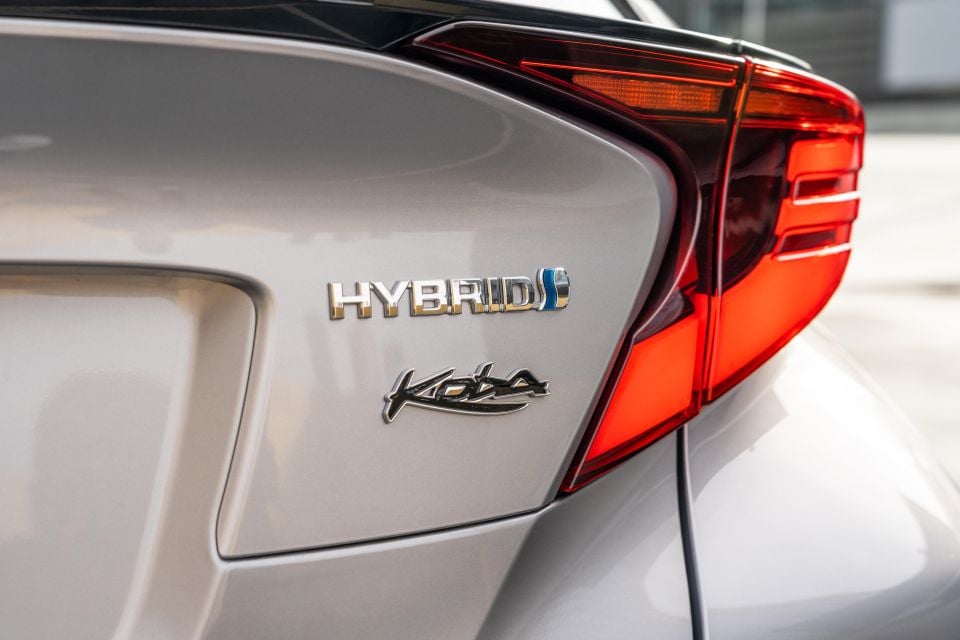
Toyota C-HR
The Toyota C-HR is covered by the brand’s five-year, unlimited kilometre new vehicle warranty, while the hybrid batteries are guaranteed for up to 10 years provided you stick to the servicing schedule.
Maintenance is required every 12 months or 15,000 kilometres – whichever comes first – while each visit will cost just $200 for the first five years.
At $1000 in scheduled servicing costs over the first 60 months or 75,000km, the Toyota C-HR is arguably the most affordable vehicle in its segment for ongoing maintenance.
We saw the trip computer hovering around the 5.0L/100km mark during our time with the C-HR, but saw closer to 4.0L/100km on numerous occasions with more urban-skewed commutes.
That equates to some 800-900km of realistic range from the C-HR’s 43-litre fuel tank, and the hybrid can run happily on cheaper 91 RON unleaded.

Both vehicles on test are pricey, have pretty glaring flaws in different areas, and their strengths are likewise in opposing areas.
The Kia Niro Hybrid Sport is too expensive given it misses out on numerous features available overseas, it’s also expensive to service and in many ways it feels quite old despite just reaching the Australian market.
With that said it’s spacious, has excellent infotainment and driver assistance systems, isn’t a complete bore to drive, and has the more comprehensive warranty.
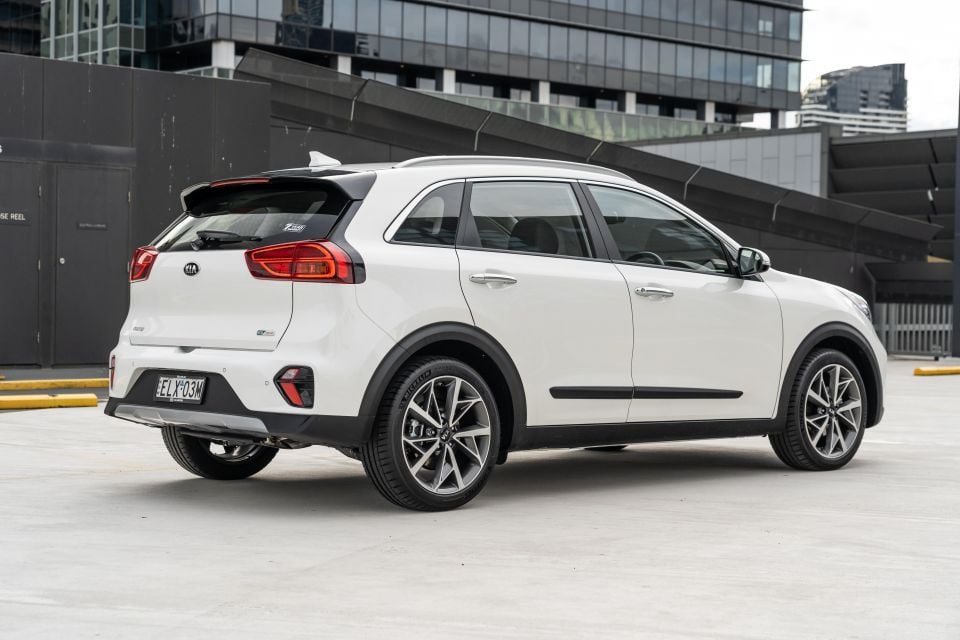

Meanwhile, the Toyota C-HR Koba Hybrid is more interesting to look at, has a classier cabin layout and is more comfortable to spend time in. It’s also less practical in the back seat and in the boot, feels like it’s lacking in performance, and like the Kia is priced perilously close to its larger RAV4 Hybrid sibling.
It’s also dirt cheap to service, and cheaper to buy than the Kia by around $3000.
While I prefer driving the Kia, the Toyota C-HR wins this comparison as it’s the better all-round proposition of this pair. However, my money would be going towards a Corolla Hybrid, Camry Hybrid or RAV4 Hybrid at this price point.
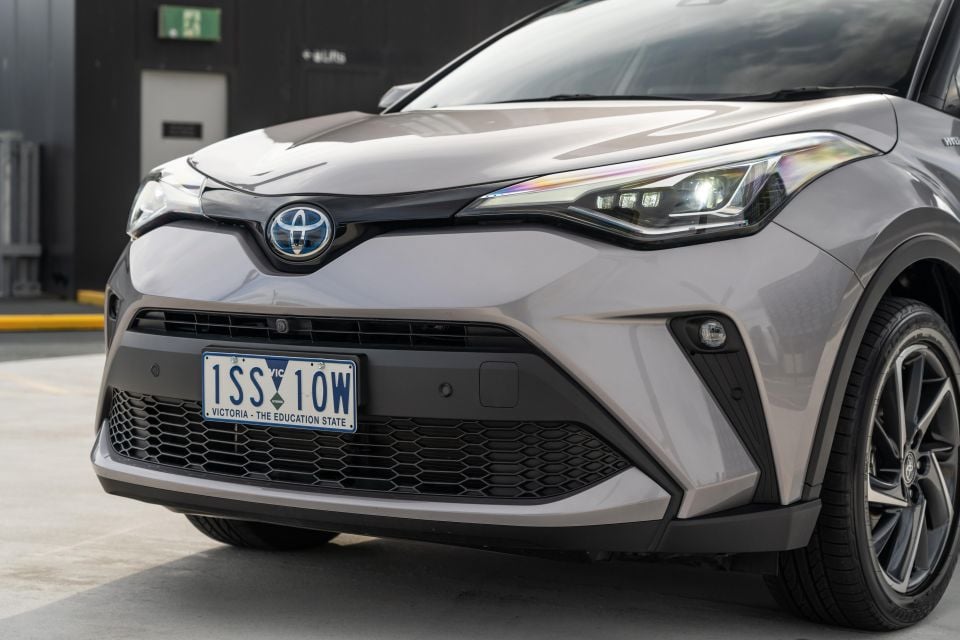
Click the images for the full gallery
MORE: Everything Kia Niro MORE: Everything Toyota C-HR
Share your thoughts with us in the comments below!
James Wong is an automotive journalist and former PR consultant, recognised among Australia’s most prolific motoring writers.
Share your thoughts and write a review of a car you own and get featured on CarExpert.


Matt Campbell
4 Hours Ago


William Stopford
20 Hours Ago


Josh Nevett
21 Hours Ago


Ben Zachariah
2 Days Ago


CarExpert.com.au
2 Days Ago


Damion Smy
2 Days Ago